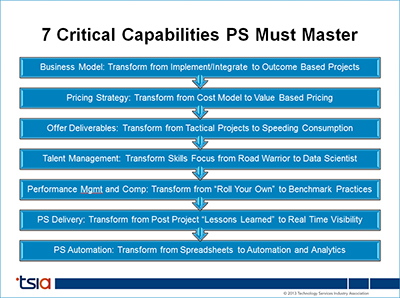
Critical Capabilities for Professional Services
According to the recent paper by the Technology Services Industry Association (TSIA), The State of Professional Services: 2013, recent trends in cloud computing and managed service models are changing what professional services firms are willing to pay and how they are willing to pay for solutions delivered in the cloud, as stated during a recent webcast…
- The “pay up front” model from the on-premise world is quickly dying
- Future spend is now tied to consumption; how well technology is adopted and how much value is received
- Traditional professional services (PS) business (implement/integrate/customize) is shrinking as on-demand reduces complexity and adds business user-focused controls
TSIA then contends that because of the pressures to drive margins, optimize the business, innovate, and then support these product trends means that to stay alive, every large, technology-focused professional services organization must have these capabilities mastered:

- Business Model: Transform from implement to integrate to outcome based projects
- Pricing Strategy: Transform from cost model to value based pricing
- Offer Deliverables: Transform from tactical projects to speeding consumptions
- Talent Management: Transform skills focus from road warrior to data scientist
- Performance Management and Compensation: Transform from “roll your own” to benchmark practices
- Professional Services Delivery: Transform from post project “lessons learned” to real time visibility
- Professional Services Automation: Transform from spreadsheets to automation and analytics
So how do professional services firms hone in on these seven critical capabilities?
Services Resource Planning (SRP): The Quickest Fix
When Planview was asked to be a part of this analysis, there was a natural “Eureka!” moment. As described in the last half of the State of Professional Services: 2013 report, the new Services Resource Planning enterprise technology makes a strong claim to automating five of these seven critical capabilities.
Specifically, as a variation and improvement to typical professional services automation (PSA), a Service Resource Planning (SRP) solution is focused solely on the processes between sales and invoicing (or as the process is more often described, including on this blog, Quote-to-Cash). Because the SRP technology has this specific focus, the ability to provide automation and visibility into business model, pricing strategy, offer deliverables, retaining talent, and PS delivery is at the core of what it has been designed to do.

Perhaps this is also why Service Performance Insight, in a white paper titled “Dwell or Excel: Leadership in Large Professional Services Organizations”, that was recently published that in 2012, PS organizations with an SRP solution that was integrated with other LOB technologies saw an 8% improvement in billable utilization, 2% improvement in project margin, and saw a $30K increase in revenue-per-employee.
Learn more about these findings:
Download the TSIA Research Report, The State of Professional Services: 2013.
Download the cited research by Service Performance Insight, Dwell or Excel: Leadership and the Large PSO.
If you would any more information about these findings, including links to analyst webcasts and more research, email [email protected] or comment below.




